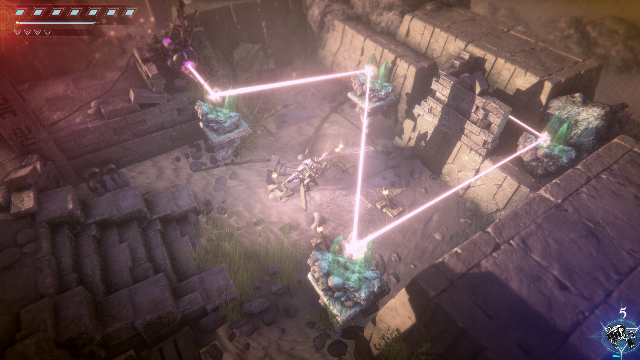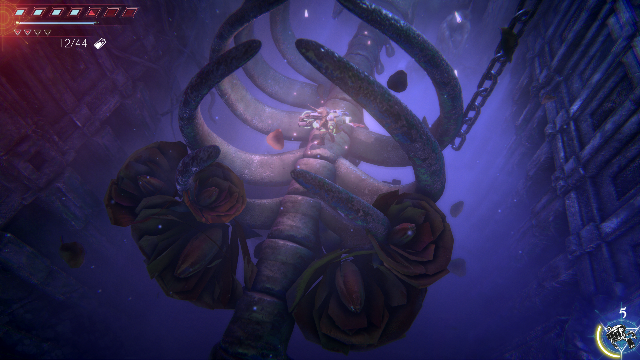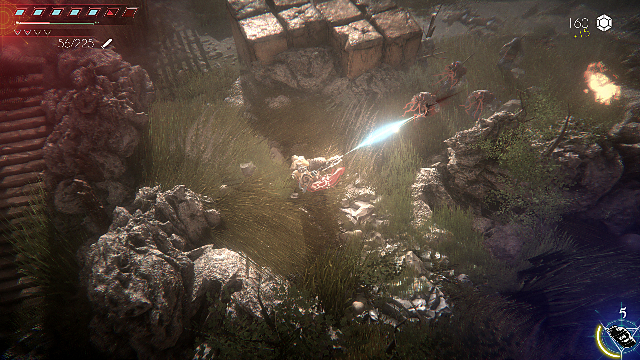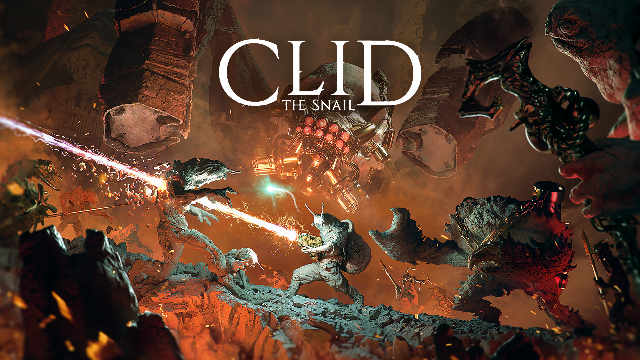Clid the Snail is an odd sort of game. It features twin-stick shooter controls, but its pacing is more akin to an adventure or role-playing game. The world is stunningly atmospheric and offers one of the most interesting new backdrops I’ve seen lately. It’s a dark, grim game with humor and interesting characters, yet it consistently trips up thanks to a stunning lack of balance and consistency.
Taking the role of gruff, gun-loving snail, Clid (yes, it’s a math nerd joke), is frequently a fun and intense experience, but the game doesn’t seem to know exactly where it’s going at any given time. Things start off almost leisurely, as Clid begins his adventure to fight off an invading army of slugs who have spread across the land very much like a squishy and disgusting plague.
Clid the Snail Review: Locked, Loaded, and Shell-Shocked

Starting with only a laser rifle, which can be charged up for a super shot, Clid can easily mow down the initially slow and infrequent enemies he comes across. Soon on, he’ll encounter an unhinged, pyromaniac mouse and gain a flame thrower, before joining up with an eclectic group of outcasts led by a strangely greedy chameleon.
The interaction between Clid and this group stays fairly cold through much of the game. That mouse he killed was the turtle shaman’s best bud, so that guy hates you. The leader only cares about earning coin and respect by helping out the various and isolated animal enclaves, and the others are just an odd bunch of traumatized survivors. Thankfully, these characters and their world are fascinating.
There’s a whole mythology and history between the different species and specific characters Clid encounters. Much of that history is brutal, awful, and horribly violent. The fact that the game clearly takes place on Earth after humans have gone extinct is another great facet of the story. Referred to as giants, the remains of humanity have resulted in a religious and sometimes cult-like following.
Far from being a happy and bright talking animal game, Clid’s world is dark and full of ruins, remains of the old world, death traps, and constant reminders of war. Even the brightly lit levels, like a scorching desert and strange robotic fish town, have an oppressive atmosphere. The graphics are excellent, with sharp details across the landscape and excellent-looking character designs.
There are times when that landscape gets in the way of your view, though, and the multi-level perspective can lead to frustration because precise aiming at higher or lower levels is clumsy at best. Throwing grenades over walls or past obstacles is nearly impossible and the bouncy grenade physics can easily cause an unfortunate unintentional suicide.
Different types of enemies abound. Sword-bearing slugs that just run at you, slugs with shields, grenade and crossbow slugs, giant moles, huge hulking slug trolls, and various other largely standard enemy archetypes await. The larger enemies require a mix of strategies, usually involving explosives and just the right gun choice.
When fully armed and stocked, Clid is a walking death machine. With 10 distinct guns, most made available fairly early on, there’s a lot of ways to smoke snails. A shotgun, circular blade launcher, goo grenade launcher, stunning electro gun, fast-shooting laser gun, and more await the very eager Clid. Everything but his base rifle requires ammunition and he can only carry a limited amount of ammo, secondary weapons, and medkits.
Between levels, Clid can use money and other items earned during a mission to upgrade his shell, holding capacity, and other stats, but the game is in no danger of reaching RPG-like character-building territory.

The real problem with Clid is his very snail-like nature feels so at odds with the action. When just wandering around the main map of the first mission, enemy numbers are (for a while) kept fairly low and manageable. The game lulls you into a false sense of security for this first bit before suddenly shoving Clid into a painfully overlong arena sequence where he must single-handedly defend a gate from invaders.
Nothing prior prepares you for this. The game just suddenly leaps from one pace and difficulty level to an extreme new one. As it turns out, it veers a lot as things progress. Those arena sequences become the norm for the end of each mission, though you’ll probably get the combat rhythm down better after a while.
There’s a decided problem turning a game with a remarkably slow-moving character into something nearly as hectic as an old-style arcade twin-stick shooter. Clid is painfully slow to reload, dodge, and even run. He has a limited stamina meter as well for roll dodging and running, and no other physical abilities.
When getting mobbed with multiple styles of enemies coming from multiple directions, for instance, throwing mines or grenades by holding down the trigger to extend a throw arc becomes agonizing. A couple of times, the game throws you right into a harsh combat situation without even giving Clid a chance to restock ammo and supplies, though the merchant hermit crab is usually placed at the beginning or end of each new section.
More problematic are the platformer-type antics. There are frequent death drops where Clid must literally roll across a gap instead jumping. Rolling, however, is haphazard, sluggish (snailish?), and requires precise timing. This makes tasks like having to rapidly and repeatedly roll across moving smashing pistons with deadly saltwater between amazingly unfun.
Finally, there are lots of puzzles here, often involving things like reflecting lasers off movable gems to open doors. Most of them are fairly simple, but the game will throw in puzzles that require the use of a specific weapon. This is fine when the game actually tells you about this added gun mechanic, but sometimes it either doesn’t tell you or did so in a blink and you missed it. Like, say, the fact that the flamethrower can heat up certain reflecting crystals to turn them.
Clid the Snail Review — The Bottom Line

Pros
- Great atmosphere, world, and story
- Excellent variety of weapons
- Looks and sounds great
- Lots of challenge
Cons
- Clid’s slower pace feels at odds with much of the action
- Riotously uneven pacing and difficulty spikes
- Platforming rolling segments can be annoying
- Some of the puzzles are incredibly obscure
There’s a lot to like in Clid the Snail. The world itself is the main draw. It’s a wonderfully grim and strange apocalyptic setting full of interesting characters, history, and sights.
When it works, the gunplay is strategic and entertaining, but too often it just never gels right leading to frustrating difficulty spikes and control issues.
[Note: The writer purchased the copy of Clid the Snail used for this review.]







Published: Sep 7, 2021 09:44 pm